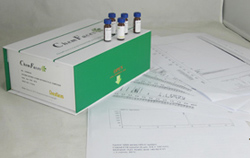Hot Products



| Catalog No. | Information |
| CFN99956 | Carnosol Carnosol, a novel agonist of TRPA1 with an EC50 value of 12.46 uM, which exhibits anti-inflammatory, anti-nociceptive, hepatoprotective, antioxidant, anticarcinogen, anti-angiogenic, anti- invasive and antimetastatic properties. Carnosol can cause a significant decrease in both bacterial and yeast growth whilst, it may prove useful as a food antioxidant which could also contribute to the retardation of the microbial spoilage of foods; it also can inhibit adipocyte differentiation in mouse 3T3-L1 cells through induction of phase2 enzymes and activation of glutathione metabolism, it may be a potential drug against obesity-related diseases. |
| CFN70485 | Carvacryl acetate Carvacryl acetate, a TRPA1 receptor agonist, which has anti-inflammatory, antioxidant, anxiolytic-like, and anti-epilepsy activities. It exhibited anti-inflammatory activity in mice by reducing inflammatory mediators, neutrophil migration and cytokine concentration, and anti-nociceptive activity due to the involvement of capsaicin and glutamate pathways. Carvacryl acetate seems to have an anxiolytic-like effect, probably due to GABAergic agonist action, without psychomotor side effects. Carvacryl acetate also shows neuropharmacological effects on δ-aminolevulinic dehydratase, Na+, K+-ATPase activities and amino acids levels in mice hippocampus after seizures. Carvacryl acetate at 6.25 μg/mL has antischistosomal activity. |
| CFN99239 | Caryophyllene oxide Caryophyllene oxide, an oxygenated terpenoid existed in many plant essential oil, is well known as preservative in food, drugs and cosmetics with antifungal, acaricidal, anti-inflammatory, anti-carcinogenic, significant central as well as peripheral analgesic and skin penetration enhancing properties. Caryophyllene Oxide and lupenone have synergistic effect against Trypanosoma cruzi. It inhibited growth and induces apoptosis through the suppression of PI3K/AKT/mTOR/S6K1 pathways, ROS-mediated MAPKs activation, and via modulation of 15-LOX. |
| CFN70403 | Cascaroside A Reference standards. |
| CFN90826 | Cassiaside Cassiaside has significant hepato-protective effects against galactosamine damage, which is higher than that of silybin from Silybum marianum. Cassiaside demonstrates significant antimutagenic, and 1,1-diphenyl-2-picrylhydrazyl(DPPH) radical scavenging effects. Cassiaside and emodi show mixed-type inhibition against β-site amyloid precursor protein (APP) cleaving enzyme 1 (BACE1). |
| CFN91123 | Cassiaside B Reference standards. |
| CFN91134 | Cassiaside B2 Reference standards. |
| CFN95120 | Cassiaside C Reference standards. |
| CFN70296 | Castalin Castalin has antioxidant activity and yeast α-glucosidase inhibitory activity. |
| CFN98251 | Catalpol Catalpol is a kind of enzyme inhibitors, it has been shown to have antioxidation, anti-inflammation, anti-apoptosis and other neuroprotective properties and plays a role in neuroprotection against hypoxic/ischemic injury, AD and PD in both in vivo and in vitro models.Catalpol regulates cholinergic nerve system function through effect on choline acetyl-transferase not M receptor affinity, it has a wide spectrum of targets including Bcl-2 , PI3K, Akt-eNOS, caspase. |